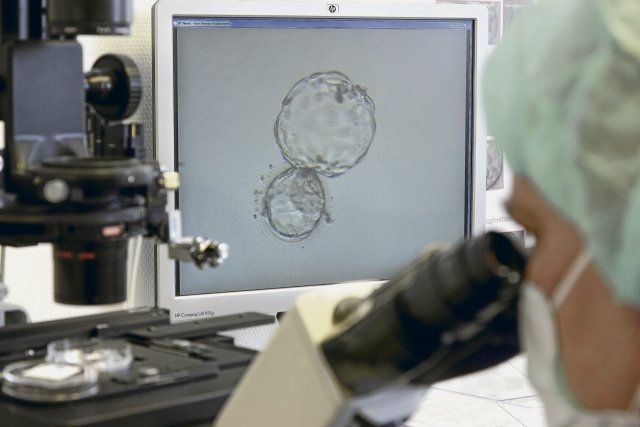During in vitro fertilization, the egg and sperm are brought together in a test tube. The removal of eggs from the body is preceded by stressful hormonal stimulation.
Photo: image/epd
Not every long-cherished wish comes true under the Christmas tree – and a real child is actually rarely in the crib. According to the Federal Ministry for Family Affairs (BMSFJ), every tenth couple between the ages of 25 and 59 has an unfulfilled desire to have children. Many hope to become parents after all with the help of reproductive medicine.
Not everything that is technically possible in this field is also legal in Germany. Sperm donation has been officially regulated since 1986 and has never been banned. And in vitro fertilization (IVF) of one’s own eggs is also permitted and is even subsidized proportionately – for (married) heterosexual couples. Only: After three attempts it’s over. Further experiments or other paths are only open to those who can afford it. A treatment cycle costs 3,000 to 3,500 euros, not including the cost of medication for hormonal stimulation.
Egg transfers, i.e. the implantation of someone else’s eggs, and surrogate pregnancies are prohibited in Germany; this is regulated by the Embryo Protection Act of 1990. Currently, around 1,000 to 3,000 couples travel abroad every year to use in-vitro fertilization with third-party eggs. By setting up a second working group in the commission, which was originally intended to deal with possible new regulations on abortion, the FDP has negotiated an examination of the legalization of altruistic “egg donation” and “surrogacy”. But what does that actually mean? For the intended parents, egg donors and people carrying a surrogate pregnancy? And who makes money from it?
nd.DieWoche – our weekly newsletter

With our weekly newsletter nd.DieWoche look at the most important topics of the week and read them Highlights our Saturday edition on Friday. Get your free subscription here.
Those treated are often older
In the media, the topic of reproductive technologies is primarily discussed from the perspective of those who are involuntarily childless: documentaries accompany them during medical examinations and show fully furnished and empty children’s rooms. Viewers experience the hope, setbacks and psychological stress of the couples up close. And they actually push their limits: financially, psychologically and physically.
People who travel abroad for an egg transfer are often older – they may have tried for a long time to get pregnant through traditional methods or have unsuccessfully used IVF treatments at home. The risks of pregnancy are correspondingly high. In a study by the Charité published in 2021, the 141 pregnancies observed showed, among other things, increased rates of preeclampsia (commonly known as pregnancy poisoning), a more frequent occurrence of premature births and low birth weights, and an increased risk of severe blood loss during birth.
The majority of the pregnant women were between 40 and 50 years old. 39 percent of them had already given birth to a child. The reporting, however, is dominated by young couples, most of whom have a previous illness that has led to childlessness. In fact, it is primarily those people who use fertility treatments whose age makes pregnancy unlikely. The fertility of people with a uterus begins to decline in their mid-20s – and deteriorates again drastically in their mid-30s.
It is understandable that people who have a strong desire to have children take great risks – but what about those who become helpers of these wishes? The motives of people who give up their eggs and how they experience the procedure receive little attention in the media. Things look a little different with surrogate pregnancy. Documentaries showed the surrogate mothers in Ukrainian bunkers at the beginning of the Russian war of aggression and focused primarily on the extreme situation. However, the medical risks associated with assisted reproduction are rarely discussed publicly.
Risks of egg retrieval
Egg retrieval is an invasive procedure that is preceded by hormone treatment to increase the number of eggs that mature per cycle. This procedure involves risks. These included ovarian hyperstimulation syndrome (OHSS), which in mild cases is primarily characterized by enlargement of the ovaries and malaise, but can also lead to fluid accumulation in the abdomen and, in severe cases, even kidney failure. Figures on the frequency of OHSS vary widely. It is true that stimulation protocols have now become more refined. However, the numbers from the German IVF register, for example, cannot be easily transferred: people from whom eggs are removed for classic IVF are, on average, older than “donors”. However, the risk of OHSS is higher in younger people.
In addition, classic IVF aims to retrieve up to ten eggs per cycle; in Germany the average is 9.2. For egg transfer from a third person, the target is 10 to 15 eggs per collection, sometimes even higher. Accordingly, the stimulation is different.
In a US survey of egg donors, 39 percent said they had moderate OHSS symptoms, and 1.2 percent of them even experienced life-threatening symptoms. The survey also highlights that the stimulation protocol, the targeted number of eggs and the frequency of delivery have a major influence on the risk of OHSS. There are also risks during removal such as anesthesia complications or vascular injuries.
A surrogate pregnancy also puts a lot of strain on the body. The person bears all the risks of a conventional pregnancy and birth, including everyday restrictions. There are also additional risks associated with pregnancies after IVF: These include a high rate of multiple pregnancies, an increased risk of diabetes and an increased risk of postpartum strokes.
What the term altruism obscures
In Germany, only surrogate pregnancy and altruistic “egg donation” are currently being discussed. But this term ignores the fact that there is an economic gap and a market behind it – because even if “egg donors” only receive compensation, others earn money from this business. In 2020, the BMFSJ recommended replacing the terms “reproductive medicine” and “artificial insemination” as these were perceived by people without children as too cold and technical and aroused associations with an “industrial process”. Only around a third of the fertility clinics in this country are publicly owned, the majority are private – with a growing participation of international corporations.
Fertility treatments are a growing market globally, in which additional services are offered in addition to the actual treatment. This includes testing egg donors for genetic predispositions for certain diseases as well as pre-implantation diagnostics on the embryo or, in some countries, gender-selective selection of embryos. Such examinations are becoming somewhat normalized here: anyone who invests so much in their desire to have children also wants a child according to their own wishes.
nd.Christmas promotion

This will be a celebration: give away nd.Digital
Give away the Superfair digital campaign subscription for 59.40 euros (9.90 euros/month).
6 months of reading »nd« digitally in the nd.App and as nd.Epaper. The subscription ends automatically.
dasnd.de/weihnachtsaktion
demo slot sbobet judi bola link sbobet
